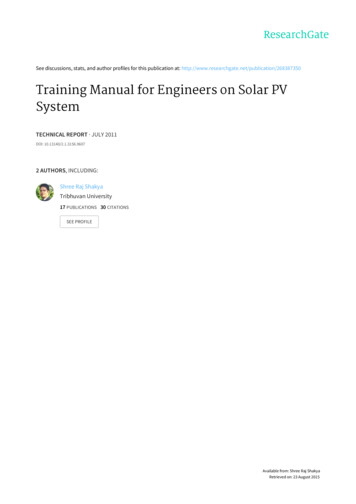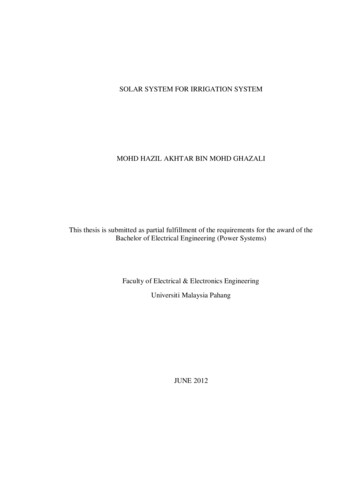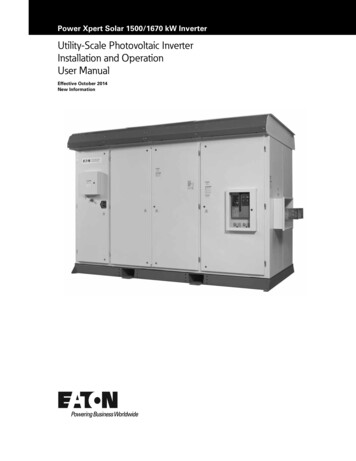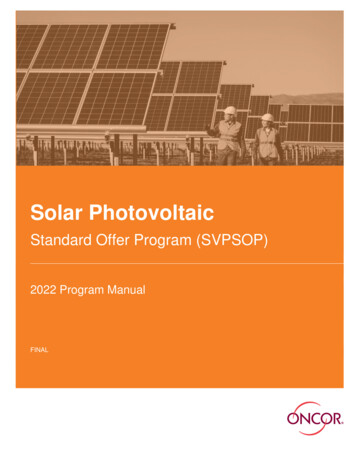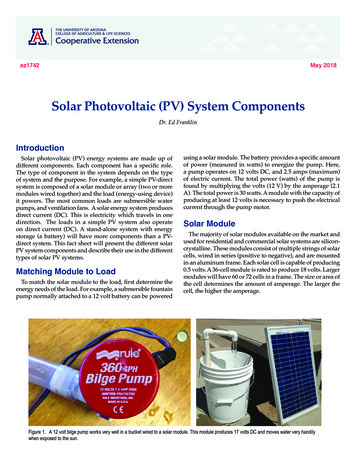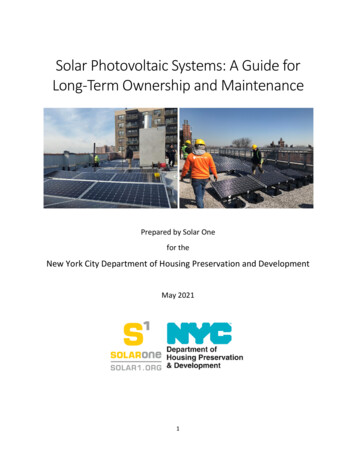
Transcription
Solar Photovoltaic Systems: A Guide forLong-Term Ownership and MaintenancePrepared by Solar Onefor theNew York City Department of Housing Preservation and DevelopmentMay 20211
Table of ContentsIntroduction . 3Solar Electric System Components . 4Solar PV System Overview . 4Solar Modules . 5Inverters . 6Mounting Systems . 7Performance Monitoring . 8Best Practices for Solar Design and Installation. 8Contractor Selection . 8Equipment Selection . 9Solar Module Selection . 9Inverter Selection . 10Mounting System Selection . 11Best Practices for Solar Project Closeout . 12Physical Completion . 12Building Inspections and Approvals . 13Roof Warranty. 13Operations & Maintenance. 13Tax Incentives and Accounting . 14Maintenance Issues and Tips . 15Monitoring Disconnected . 15Low Energy Yield . 15Inverter Error Codes. 16Inverter Failure. 17Impact and Cost of Inverter Failure . 17Module Failure and Vandalism . 18Impact and Cost of Module Failure. 18Roof Maintenance and Replacement . 19Conclusion . 20Attachment: HPD Solar Technical Requirements . 21Disclaimer: Solar One staff has made a good faith effort to provide accurate and useful information in thisdocument. Please note that this document is provided on an as-is basis. Solar One and the NYC Department ofHousing Preservation and Development make no claims regarding the accuracy of the content provided herein.Building owners installing solar are advised to consult their tax, accounting and engineering professionalsregarding their solar project.2
IntroductionThis guide is intended to serve as a resource for affordable housing developers and professionals tosupport the construction and maintenance of cost-effective and high-performance solar energy systems.Solar electricity is a mature technology; however, until recently, the cost of this technology wasprohibitive for most affordable housing developments. Now, the benefits of solar are widely recognized,and an ever-increasing number of building owners are installing solar to reduce long-term operatingcosts.NYC has committed to 1 gigawatt of solar by 2030. Solar on private property is essential to achieving thisgoal. While Local Laws 92 and 94 of 2019 mandate solar or green roofs on all new roofs, affordablehousing is subject to the New York City Department of Housing Preservation and Development’s (HPD)alternative compliance pathway until 2024. HPD's Solar Where Feasible policy requires solar onaffordable housing when it is cost-effective, ensuring that investment in clean energy helps create andpreserve affordable housing by lowering building operating expenses, creating green jobs, and reducingharmful emissions. HPD has partnered with the New York State Energy Research and DevelopmentAuthority (NYSERDA) and non-profit Solar One to create tools to identify and optimize solar projectsacross HPD's portfolio, and to provide free technical assistance with HPD's Solar Feasibility Analysis.As of October 2020, all HPD projects are required to install solar where it is deemed cost-effective. ASolar Feasibility Analysis is required for all projects certifying through Enterprise Green Communities orLEED. For Preservation projects, a solar screening is part of the Integrated Physical Needs Assessment(IPNA) and scoping process. All solar projects must comply with HPD’s Solar Technical Requirements anduse a NYSERDA-approved solar company. Up-to-date information and resources for HPD’s Solar WhereFeasible program can be accessed here: ion/solar-where-feasible.page.Like most energy measures, the true cost-effectiveness of a solar photovoltaic (PV) system depends onlong-term system performance. Numerous studies by the National Renewable Energy Laboratory, theNew York State Energy Research and Development Authority, and other reputable research institutionsdemonstrate that solar PV systems installed over the last decade reliably generate electricity asforecasted. While solar PV performance is reliable in aggregate, individual system performance may varydepending on factors such as shading impacts, weather variability, solar technology choices, systemdesign, installation workmanship, manufacturer defects, performance monitoring, andpreventative/curative maintenance. This guide provides affordable housing professionals with anintroduction to solar PV technology, common PV system performance issues, and strategies to optimizelong-term solar PV system performance. This resource will be updated periodically through 2023, andSolar One invites your feedback, comments and questions (affordable@solar1.org).3
Solar Electric System ComponentsSolar PV System OverviewSolar electric systems convert sunlight into electricity, offsetting energy costs and reducing harmfulemissions associated with fossil fuel-based electricity generation. Solar electric systems are comprised ofsolar photovoltaic (PV) modules (a.k.a. solar panels), a mounting system to hold the modules, inverters,and smaller components such as conduit, wires & disconnect switches. Solar PV systems on multifamilybuildings are typically grid-interactive, which means the solar PV system and the electric utility bothdeliver power to the building. Most solar PV systems do not include energy storage/batteries, andcannot provide backup power during a utility blackout. Battery backup will become increasinglycommon in the coming years as the costs of batteries decline, however it is still relatively rare formultifamily solar projects in New York City. A diagram of a typical solar PV system is shown below:Image credit: City of Roseville, CA.Solar PV systems come in many shapes and sizes, ranging from small solar installations on pitched-roofsingle family homes to ballasted or elevated canopy systems on multifamily buildings or even largeground-mounted solar farms. Solar PV systems provide utility bill savings based on their energygeneration over time. Solar energy is measured in kilowatt hours, the same unit of measurement usedfor calculating electricity bills, but PV systems are typically described by adding up the capacity of eachmodule in watts. For example, a PV system composed of five 350-watt modules would be a 1,750 wattor 1.75 kilowatt (kW-DC) system, while a system using ten of the same modules would be a 3,500 wattor 3.5 kW-DC system.In the northern hemisphere, solar PV systems generate the most electricity per year when they facesouth or southwest. Solar production is the greatest during the summer months. In New York City, solarPV systems typically generate between 1,000-1,275 kilowatt hours annually per kilowatt-DC ofcapacity. This metric, known as “solar production factor”, is affected by several variables, includingsystem tilt angle, system orientation, shading, inverter efficiency, downtime for maintenance, andweather variability. Owners and managers of solar PV systems can monitor the performance of theirsolar PV systems by comparing actual energy generation with forecasted energy generation on amonthly, quarterly or annual basis.4
Solar ModulesSolar modules, also referred to as solar panels, convert sunlight into DC electricity. The majority of solarmodules installed today are crystalline silicon PV modules. A crystalline silicon solar module is typicallycomprised of 60 or 72 solar PV cells that are connected together in an assembly with an aluminumframe, glass front, encapsulant for the solar cells, a protective back sheet, and a junction box where thepower output is routed into wires that can be connected to other solar modules, inverters or poweroptimizers.As of 2021, a typical solar PV module has a capacity of 325-425 Watts-DC. The rated capacity of a solarPV module is the maximum amount of power that the module will generate in laboratory conditions.Individual solar PV module are typically 60-80 inches in length, 40 inches wide, and 1-2 inches thick, witha typical weight of 40 lbs.Solar modules are designed to reliably produce power for decades with minimal maintenance, and mostsolar modules carry a 25-year power output warranty. Solar PV module efficiency varies betweenproducts. Higher-efficiency modules are commonly selected for NYC projects, even though theygenerally cost more, because they can produce more power in a given area. Cheaper standard efficiencymodules are common but usually installed where space is not a limiting factor. The performance of thesolar modules degrades slightly over time due to normal exposure to the elements, typically at a rate of0.25-0.75% per year. Most solar PV module warranties guarantee that solar PV modules will generate atleast 80% of their rated power output at year 25, and many PV module manufacturers have enhancedwarranties which guarantee higher performance over time. Solar PV module failure is extremely rare 1,however, factors that can negatively impact PV module performance over time include shading, buildupof dust and dirt, and excessive heat.A 2017 study conducted by researchers from the National Renewable Energy Laboratory observed solar PVmodule failure rates of 0.05% per year across 54,500 solar PV systems installed and operational between 20002015. -panels-degradation.html.15
InvertersThe inverter is a crucial solar PV system component that converts the direct current (DC) electricitygenerated by solar modules to alternating current (AC) in order to match the power delivered by theutility so the two systems can interact seamlessly. The inverter is a complex piece of equipment andfunctions as the brain of the solar PV system. On the AC side, the inverter measures the electric gridvoltage and frequency, and modulates the solar PV system output to match the grid. Inverters aredesigned to shut off the solar PV system immediately in the event of a power outage to protect thesafety of utility workers who may be working to restore power.There are two primary categories of inverters:String Inverters Convert the combined output of many solarmodules into AC power at a central location. Microinverters Mounted underneath the solar modules andconvert the DC output to AC power at themodule-level. Reduces shade losses. Allows for panel-leveloptimization and monitoring.If one solar module is shaded, the wholestring will decrease in production.Module-level performance optimization can also be accomplished using DC optimizers with stringinverters. DC optimizers are small electronic devices that work in tandem with string inverters to alloweach module to operate at peak efficiency, and are typically installed beneath each module or pair ofmodules.Note: to maximize the performance of a partially-shaded solar energy system, either use microinvertersor DC optimizers.Bank of String InvertersMicroinverter (photo credit: Solar Power World)Inverter size ranges widely depending on the technology and application, however, a typical multifamilystring inverter is the size of a microwave and weighs 50-150 lbs. Individual inverters or a bank of severalinverters can be wall-mounted on the rooftop bulkhead (as pictured above left), mounted onto the roofor PV array itself, or installed in the basement electrical room. Microinverters and optimizers aremounted directly beneath solar panels, either attached to the solar module frame or the mountingsystem.Inverters are designed to reliably convert DC power to AC power in indoor or outdoor settings for adecade or more. While power conversion efficiency varies, inverters typically convert DC power to AC6
power with an efficiency of 96-99%. String inverters typically carry 10-12 year warranties (with optionalextensions to 20 years) while microinverters and DC optimizers usually have 25-year warranties.Mounting SystemsAll rooftop solar energy systems have a mounting system to attach the solar PV modules to the buildingand hold them in place. Solar mounting systems are either mechanically attached, ballasted, or acombination of both. Mechanically attached systems include anchors that mechanically integrate thesolar mounting system to the building. For pitched roofs, mechanical attachment is required andaluminum rails elevate the solar panels 2-6” above the roof surface, where they are installed co-planarwith the roof. On low slope (“flat”) roofs, light-weight mechanically attached mounting systems can beelevated a few feet above the roof surface to allow for roof access and maintenance underneath thesolar arrays. Heavy-duty mechanically attached systems can be elevated 9 feet or more above the roofsurface, and are often referred to as solar
Solar electric systems convert sunlight into electricity, offsetting energy costs and reducing harmful emissions associated with fossil fuel-based electricity generation. Solar electric systems are comprised of solar photovoltaic (PV) modules (a.k.a. solar panels), a mounting system to hold the modules, inverters,


